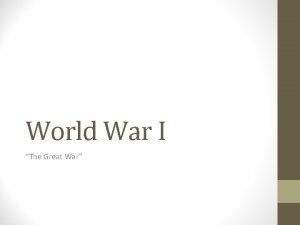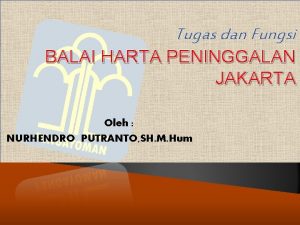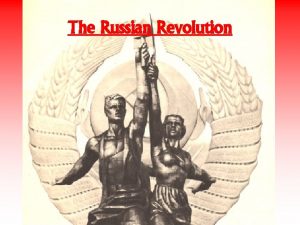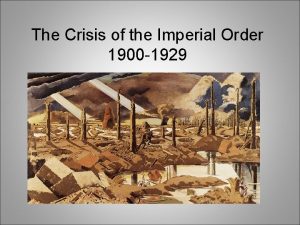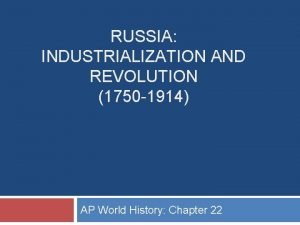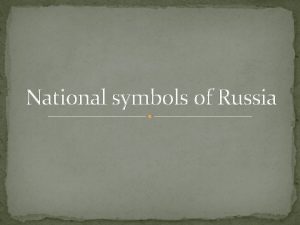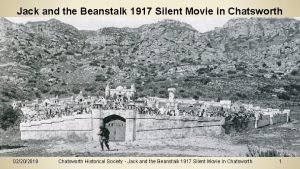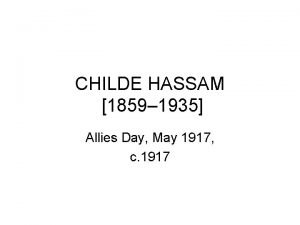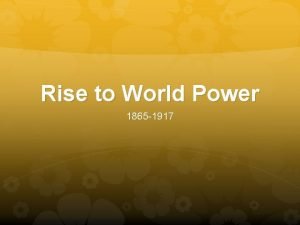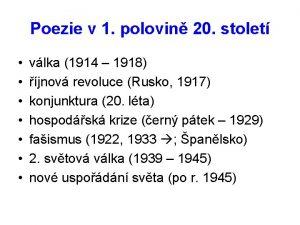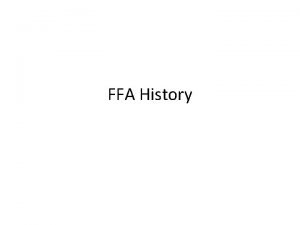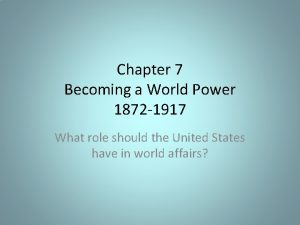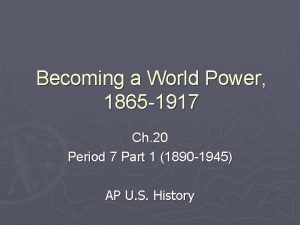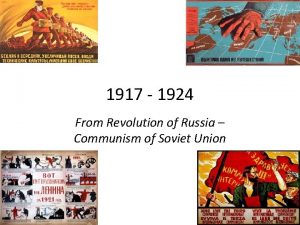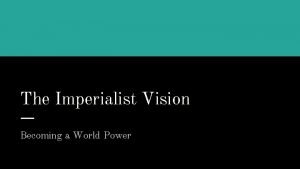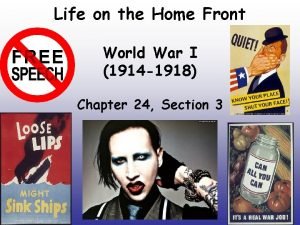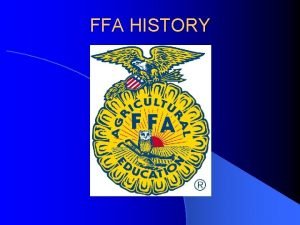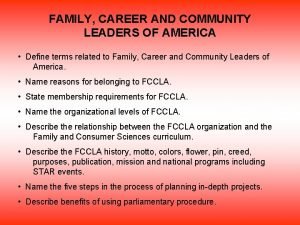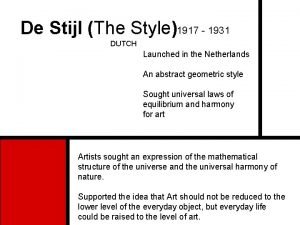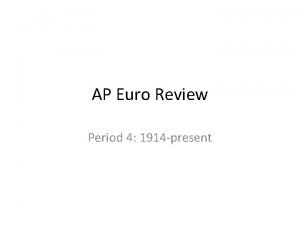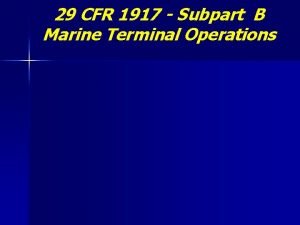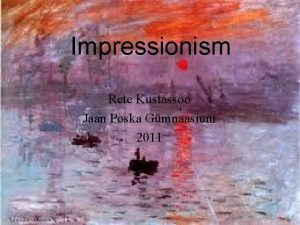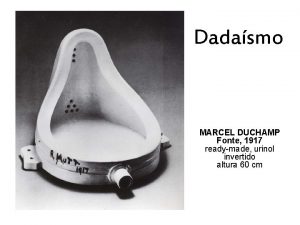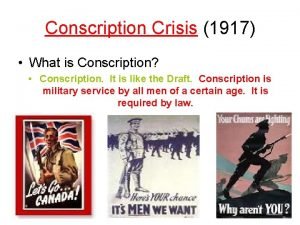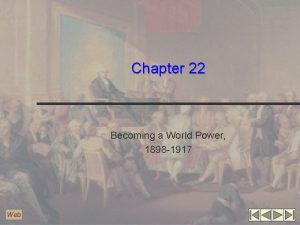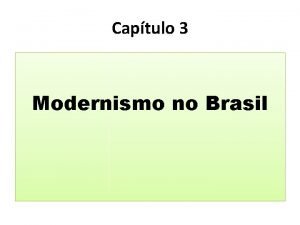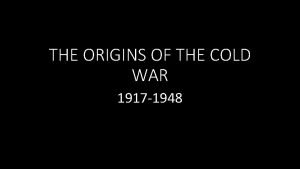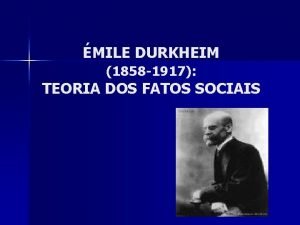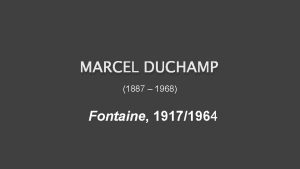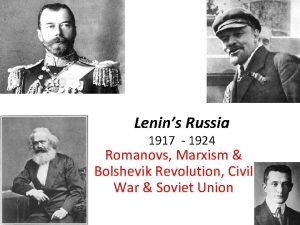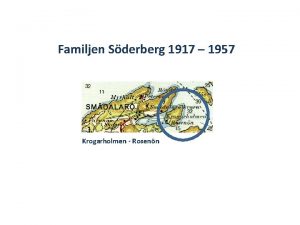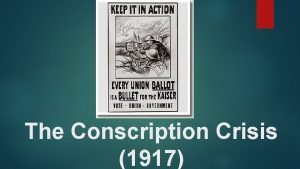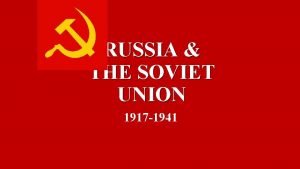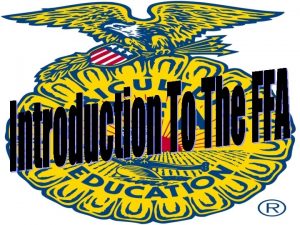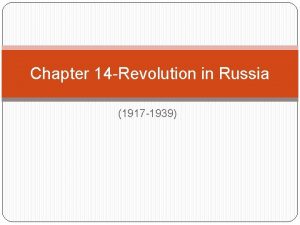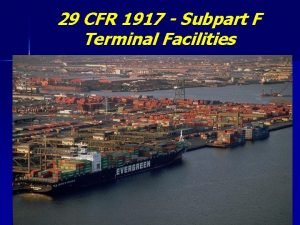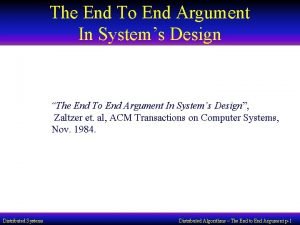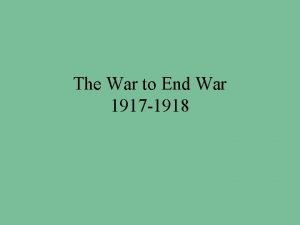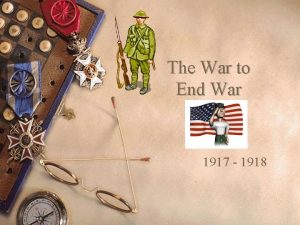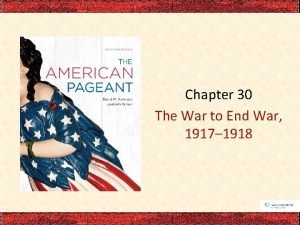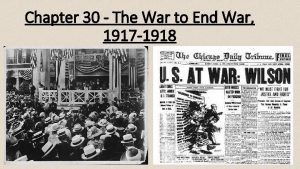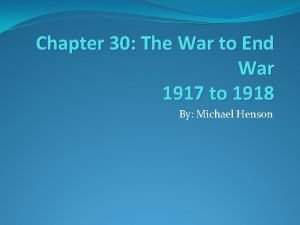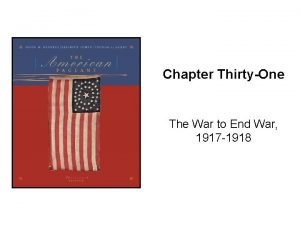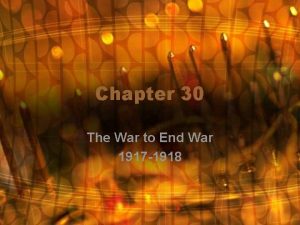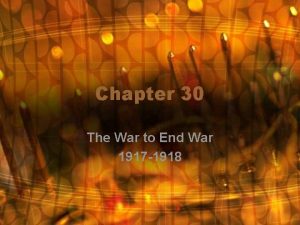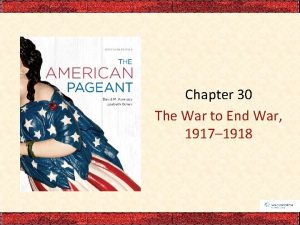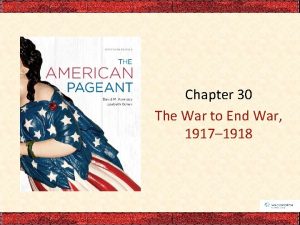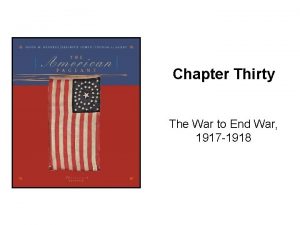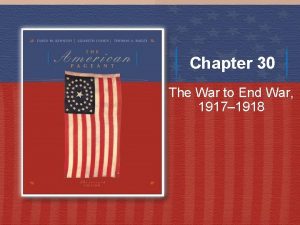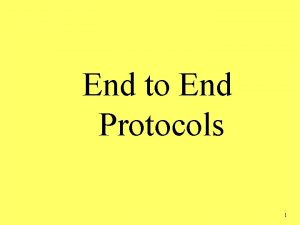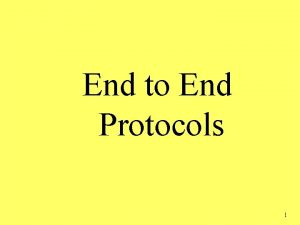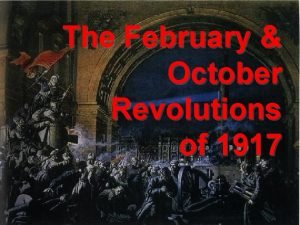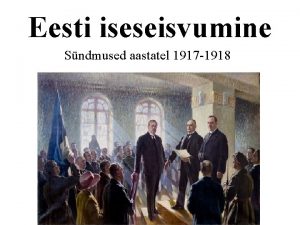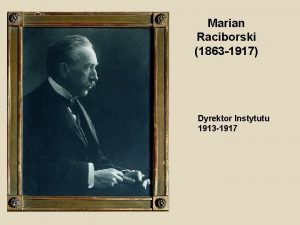Chapter 30 The War to End War 1917






























![Espionage and Sedition Acts [Remember the Alien and Sedition Acts? ] Among major targets Espionage and Sedition Acts [Remember the Alien and Sedition Acts? ] Among major targets](https://slidetodoc.com/presentation_image_h2/55ecae77cd72dd84d05f498d98ad35b5/image-31.jpg)




![Espionage and Sedition Acts continued [Remember the Alien and Sedition Acts? ] Espionage Act Espionage and Sedition Acts continued [Remember the Alien and Sedition Acts? ] Espionage Act](https://slidetodoc.com/presentation_image_h2/55ecae77cd72dd84d05f498d98ad35b5/image-36.jpg)



![Zinn on the Schenck Case continued [“clear and present danger”] Perhaps free speech could Zinn on the Schenck Case continued [“clear and present danger”] Perhaps free speech could](https://slidetodoc.com/presentation_image_h2/55ecae77cd72dd84d05f498d98ad35b5/image-40.jpg)



































- Slides: 75

Chapter 30 The War to End War, 1917– 1918

I. War by Act of Germany

1917 January 22 In a speech to Congress, President Woodrow Wilson calls for a league of peace, an organization to promote the resolution of conflicts. But neither side is willing to agree to negotiations while holding on to the prospect of victory. January 31 Having rapidly built its submarine fleet to over one hundred boats, Germany resumes unrestricted submarine warfare, believing it can starve the Allies into submission in six months {before the USA could become any serious threat to a German victory if the Americans did indeed formally enter the war}. February 3 Citing the German decision, Wilson breaks diplomatic relations with Germany [which is the step generally taken before a formal declaration of war is initiated and then ultimately issued]. 3

10 Nations Hit the Hardest by U-Boats Ship Losses during WWI by Year and Month 1914 Sep (4) Oct (6) Nov (4) Dec (1) 15 ships hit in 1914. 1915 Jan (8) Feb (11) Mar (42) Apr (39) May (66) Jun (124) Jul (102) Aug (126) Sep (70) Oct (47)Nov (68) Dec (51) 754 ships hit in 1915. 1916 Jan (37) Feb (56) Mar (81) Apr (110) May (68) Jun (73) Jul (97) Aug (151) Sep (199) Oct (205) Nov (217) Dec (223) 1517 ships hit in 1916. 1917 Jan (220) Feb (328) Mar (411) Apr (510)May (411) Jun (429) Jul (309) Aug (240) Sep (243) Oct (215) Nov (174) Dec (207) 3697 ships hit in 1917. [Most sunk in one year of the war] 1918 Jan (185) Feb (165) Mar (230) Apr (165) May (193) Jun (133) Jul (156) Aug (186) Sep (123) Oct (92) Nov (11) 1639 ships hit in 1918. 1919 Jan (1) 1 ships hit in 1919. Country British 3, 714 Norwegian French 793 Italian Greek Danish 257 Russian Dutch Swedish American Total Attacks 798 682 272 194 181 179 174 7, 244 4

Zimmerman Note 1917 February 24 In what will become known as the Zimmerman Telegram incident, the British Secret Service intercepted a telegram from German Foreign Minister Arthur Zimmermann to the German ambassador in Mexico, attempting to incite Mexico to join Germany’s side in the event of war with the United states. In return, Germany promises to help Mexico recover Texas, New Mexico, and Arizona. The British have held the note until an appropriate moment when its revelations will presumably push Wilson over the brink of his wavering neutrality and into the war. After the telegram is released, there is an angry public outcry over what is considered German treachery. 5


Would Mexico go to war with the USA on the side of the Central Powers? The Zimmerman Note involved a proposed secret agreement between Germany and Mexico. (Germany promised to give back to Mexico territory it lost in the Mexican Cession if (Carranza’s) Mexico went to war against the USA. ) [The German Ambassador to Mexico was Arthur Zimmerman; the British intercepted the telegram but waited until they obtained a Mexican copy so as not letting the Germans know they could decipher their codes and then gave it to USA. ] Arthur Zimmerman 7

1917 February 26 After asking Congress for permission to arm merchant ships, Wilson is told by his attorney general that he, in fact, has that power. Wilson then issues the directive on March 9. March 15 The Czar of Russia is forced to abdicate after the Russian Revolution. The U. S. government recognizes the new government formed by Alexander Kerensky. March 12 -21 Five more American ships are sunk, all without warning. [Were they all armed yet neutral? ] April 2 Wilson asks Congress to declare war on Germany. {Two days later Congress, on April 4 th, the Senate and House of Representatives both, vote for a declaration of war formally joining the Allies against the Central Powers in the Great War (WWI). } 8

II. Wilsonian Idealism Enthroned • Wilson reluctantly broke our isolationism • How convince Americans to support war? • Make the “World Safe for Democracy”

III. Wilson’s Fourteen Potent Points 1918 January 8 Wilson’s Fourteen Points for peace speech. The speech outlines a generous and liberal attempt to settle the war. Georges Clemenceau 10

Wilson’s Fourteen Points con’t The following were among Wilson’s 14 Points upon which he based America’s idealistic foreign policy in WWI: reduction of armaments, abolition of secret treaties, Freedom of the seas, a new international organization to guarantee collective security (League of Nations), and the principle of national self-determination (autonomy) for subjugated peoples (from imperialist powers) (Ex. Poland but not Syria, Iraq, or Palestine); What about international religious freedom and toleration? No! [French Prime Minister Clemenceau says the Fourteen points “bore him, ” and adds, “Even Almighty God has only ten. ”] 11

IV. Creel Manipulates Minds

Civilian War-Related Agencies Civilian administrators and WWI mobilization agencies: George Creel – Committee on Public Information Herbert Hoover – Food Administration Bernard Baruch – War Industries Board William Howard Taft – National War Labor Board Herbert Hoover Bernard Baruch William Howard Taft 13

The Committee on Public Information, also known as the CPI and the Creel Committee, was an independent agency of the government of the United States intended to influence U. S. public opinion regarding American intervention in World War I The purpose of the CPI was to influence American public opinion toward supporting U. S. intervention in World War I via a prolonged propaganda campaign. The CPI at first used material that was based on fact, but spun it to present an upbeat picture of the American war effort. Very quickly, however, the CPI began churning out raw propaganda picturing Germans as evil monsters. Hollywood movie makers joined in on the propaganda by making movies such as The Claws of the Hun, The Prussian Cur, To Hell With The Kaiser, and The Kaiser, the Beast of Berlin. These titles illustrated the message the CPI tried to convey. 14

The Committee on Public Information continued This raw propaganda included complete fabrications, such as images and stories of German soldiers killing babies and hoisting them on bayonets. CPI pamphlets were created and warned citizens to be on the lookout for German spies. Dozens of "patriotic organizations, " with names like the American Protective League and the American Defense Society, sprang up. These groups spied, tapped telephones, and opened mail in an effort to ferret out "spies and traitors“ {many of the things they did were illegal}. The targets of these groups was anyone who called for peace, questioned the Allies' progress, or criticized the government's policies. They were particularly hard on German Americans, some of whom lost their jobs, and were publicly humiliated by being forced to kiss the American flag, recite the Pledge of Allegiance, or buy war bonds {or worse, such as beaten, etc…}. The committee used newsprint, posters, radio, leaflets, pamphlets, telegraph, cable and movies to broadcast its message. There was a volunteer services corps, called the Four-minute men whose 75, 000 members spoke around the country. The Four-minute men worked in 5, 200 communities and gave 755, 190 speeches. During its lifetime, the organization had over twenty bureaus and divisions, with commissioner's offices in nine foreign countries. In addition to the Four-minute men both a Films Division and a News Division were established to help get out the war message. (See later slides. } What was missing, Creel saw, was a way to reach those Americans who might not read newspapers, attend meetings or watch movies. For this task, Creel created the Division of Pictorial Publicity. 15

The Committee on Public Information continued Charles Dana Gibson was America's most popular illustrator (“Gibson Girls”) - and an ardent supporter of the war. When Creel asked him to assemble a group of artists to help design posters for the government, Gibson was more than eager to help. Famous illustrators such as James Montgomery Flagg (Uncle Sam), Joseph Pennell, Louis D. Fancher, and N. C. Wyeth were brought together to produce some of World War I's most lasting images. Committee work was curtailed after July 1 st, 1918. Domestic activities stopped after the Armistice was signed on November 11 th, 1918. Foreign operations ended June 30, 1919. The CPI was abolished by executive order 3154 on August 21 st, 1919. A major problem for George Creel’s Committee on Public Information was that he oversold President Wilson’s ideals, which led the world to expect too much from Wilson. Charles Dana Gibson A “Gibson Girl” Drew Attention George Creel 16

Remember “Gibson Girls” of the Gilded Age before “Flappers” of the 1920 s! “Gibson Girl” Tumblers 17

James Montgomery Flagg

p 681

Was the Creel Commission popular? During World War I, Lippmann and Bernays were hired by then United States President, Woodrow Wilson, to participate in the Creel Commission, the mission of which was to sway popular opinion in favor of entering the war, on the side of the United Kingdom. The Creel Commission provided themes for speeches by "four-minute men" at public functions, and also encouraged censorship of the American press. The Commission was so unpopular that after the war, Congress closed it down without providing funding to organize and archive its papers. The war propaganda campaign of Lippmann and Bernays produced within six months such an intense anti-German hysteria as to permanently impress American business (and Adolf Hitler, among others) with the potential of large-scale propaganda to control public opinion. Bernays coined the terms "group mind" and "engineering consent, ” very important concepts in practical propaganda work. 20

Propaganda Poster Presented by the Committee on Public Information "U. S. Official War Pictures", propaganda poster by Louis D. Fancher 21

Propaganda Film Presented by the Committee on Public Information [The Second Official United States War Picture] 22

More Propaganda Films Presented by the Committee on Public Information 23

Some Propaganda Posters of the Committee on Public Safety In no degree was the Committee an agency of censorship, a machinery of concealment or repression. Its emphasis throughout was on the open and the positive. At no point did it seek or exercise authorities under those war laws that limited the freedom of speech and press. In all things, from first to last, without halt or change, it was a plain publicity proposition, a vast enterprise in salesmanship, the world's greatest adventures in advertising… We did not call it propaganda, for that word, in German hands, had come to be associated with deceit and corruption. Our effort was educational and informative throughout, for we had such confidence in our case as to feel that no other argument was needed than the simple, straightforward presentation of the facts. - George Creel 24

Enthusiasm in song

Patriotic Music “Over There” - by George M. Cohan “Over there, over there, Send the word, send the word over there That the Yanks are coming, The drums rum-tumming ev'rywhere. So prepare, say a pray'r, Send the word, send the word to beware. We'll be over, we're coming over, And we won't come back till it's over there. ” http: //www. youtube. com/watch? v=B 6 h. RDS 3 Lv. QQ 26

George Michael Cohan Song Credits Include: Over There You're a Grand Old Flag Yankee Doodle Dandy Give My Regards to Broadway Only 45 Minutes from Broadway George Michael Cohan (pronounced "Coe-han") (July 3, 1878– November 5, 1942), known professionally as George M. Cohan, was an American entertainer, playwright, composer, lyricist, actor, singer, dancer and producer. Known as "the man who owned Broadway" in the decade before World War I, he is considered the father of American musical comedy. A full-length dramatic musical entitled George M that depicted his life and which celebrated his music was produced on Broadway in 1968, as did the Academy Award-winning film Yankee Doodle Dandy (1942) starring James Cagney. 27

WE DON’T WANT THE BACON – WHAT WE WANT IS A PIECE OF THE RHINE (RIVER)! That sounds like a cool war song don’t you think. Could you rap that or perhaps head-bang to it? 28

I Didn't Raise My Boy to be a Soldier One of the few anti-war songs of the First World War, this American song was also sold in Canada. The chorus is: I didn't raise my boy to be a soldier, I brought him up to be my pride and joy, Who dares to put a musket on his shoulder, To shoot some other mother's darling boy? Let nations arbitrate their future troubles, It's time to lay the sword and gun away, There'd be no war today, If mothers all would say, I didn't raise my boy to be a soldier. 29

V. Enforcing Loyalty and Stifling Dissent • Tough times to be German American • “liberty cabbage” “liberty steak”
![Espionage and Sedition Acts Remember the Alien and Sedition Acts Among major targets Espionage and Sedition Acts [Remember the Alien and Sedition Acts? ] Among major targets](https://slidetodoc.com/presentation_image_h2/55ecae77cd72dd84d05f498d98ad35b5/image-31.jpg)
Espionage and Sedition Acts [Remember the Alien and Sedition Acts? ] Among major targets of wartime Espionage and Sedition Acts were: the Industrial Workers of the World (IWW/”Wobblies”), Eugene V. Debs (not a Supreme Court Case but the Socialist), and German-Americans. L Espionage Act 1917/Sedition Act 1918 (Sedition is treason. ) Supreme Court presented in textbook as unbiased when ruling in Schenck v. USA in 1919 – can curb speech when “clear and present danger” to the nation exists – but who decides – think of US v. Spirit of ’ 76 because it portrayed British atrocities, which they did commit during the American Revolution, but as our WWI allies, the truth was not acceptable – why? (contrast with Birth of a Nation) {Similarities of 1790 s Alien and Sedition Acts and Espionage and Sedition Acts of 1917 -1918} 31

1917 The Espionage Act is passed by Congress, ostensibly to prevent spying. However, it is used chiefly to silence American critics of the war. A year after its passage, Eugene V. Debs, the Socialist leader and presidential candidate(jailed for Pullman strike 1894), is arrested and sentenced to ten years in prison for making a speech that “obstructed recruiting. ” Debs actually ran for president again in 1920 from prison {receiving 900, 000 votes out of ~7 million total}, and was eventually pardoned after serving 32 months by President Harding, because President Wilson would not upon leaving office. Eugene V. Debs, Warren G. Harding, and Woodrow Wilson 32

• “Your Honor, years ago I recognized my kinship with all living beings, and I made up my mind that I was not one bit better than the meanest on earth. I said then, and I say now, that while there is a lower class, I am in it, and while there is a criminal element I am of it, and while there is a soul in prison, I am not free. ” 33

Learning of Debs' ill health, Attorney General A. Mitchell Palmer prepared a clemency petition on Debs' behalf for a presidential pardon in order to free Debs from prison, feeling it would damage the administration if he died in custody. Upon being given the petition, President Wilson replied "Never!" and wrote "Denied" across it. On December 25 th, 1921, President Harding commuted Debs' sentence to time served (Merry Christmas); Debs was released from prison and was warmly greeted by Harding at the White House: "I have heard so damned much about you, Mr. Debs, that I am very glad to meet you personally. "

p 682
![Espionage and Sedition Acts continued Remember the Alien and Sedition Acts Espionage Act Espionage and Sedition Acts continued [Remember the Alien and Sedition Acts? ] Espionage Act](https://slidetodoc.com/presentation_image_h2/55ecae77cd72dd84d05f498d98ad35b5/image-36.jpg)
Espionage and Sedition Acts continued [Remember the Alien and Sedition Acts? ] Espionage Act 1917 and Sedition Act 1918 – fines of up to $10, 000 & 20 years in jail for interfering with draft, obstructing sale of government bonds, or saying anything disloyal, profane, or abusive about US war effort. Like Alien and Sedition Acts of 1798, violate spirit of 1 st Amendment – 6, 000 arrests in WWI – 1, 500 convictions: • Rev. Williams got 15 years for telling Bible class that Christians should not take part in war • Loss of mailing privileges - ex. NY Times and Saturday Evening Post temporarily • Columbia University fired Professor with antiwar views, so colleague resigned in protest stating, “If we have to suppress everything we don’t like to hear, this country is resting on a pretty wobbly basis. ” Debs, Goldman, IWW, civil liberties of USA hindered. 36

Alien & Sedition Acts 1798 • A series of laws known collectively as the Alien and Sedition Acts were passed by the Federalist Congress in 1798 and signed into law by President Adams. • These laws included new powers to deport foreigners as well as making it harder for new immigrants to vote. • Previously a new immigrant would have to reside in the United States for five years before becoming eligible to vote, but a new law raised this to 14 years.

Schenck v. United States, (1919), was a United States Supreme Court decision which upheld the Espionage Act of 1917 and concluded that a defendant did not have a First Amendment right to free speech against the draft during World War I. Charles Schenck was the Secretary of the Socialist party and was responsible for printing, distributing, and mailing 15, 000 leaflets to men eligible for the draft that advocated opposition to the draft. These leaflets contained statements such as; "Do not submit to intimidation, ” "Assert your rights, ” "If you do not assert and support your rights, you are helping to deny or disparage rights which it is the solemn duty of all citizens and residents of the United States to retain. " Ultimately, the case served as the founding of the "clear and present danger" rule. 38

Schenck v. United States continued The Court, in a unanimous opinion written by Justice Oliver Wendell Holmes, Jr. , held that Schenck's criminal conviction was constitutional. The First Amendment did not protect speech encouraging insubordination, since, "when a nation is at war many things that might be said in time of peace are such a hindrance to its effort that their utterance will not be endured so long as men fight, and that no Court could regard them as protected by any constitutional right. " In other words, the court held, the circumstances of wartime permit greater restrictions on free speech than would be allowable during peacetime. In the opinion's most famous passage, Justice Holmes sets out the "clear and present danger" test: "The question in every case is whether the words used are used in such circumstances and are of such a nature as to create a clear and present danger that they will bring about the substantive evils that Congress has a right to prevent. " This case is also the source of the phrase "shouting fire in a crowded theater, " paraphrased from Holmes' assertion that "the most stringent protection of free speech would not protect a man in falsely shouting fire in a theatre and causing a panic. " 39
![Zinn on the Schenck Case continued clear and present danger Perhaps free speech could Zinn on the Schenck Case continued [“clear and present danger”] Perhaps free speech could](https://slidetodoc.com/presentation_image_h2/55ecae77cd72dd84d05f498d98ad35b5/image-40.jpg)
Zinn on the Schenck Case continued [“clear and present danger”] Perhaps free speech could not be tolerated by any reasonable person if it constituted a “clear and present danger” to life and liberty; after all, free speech must compete with other vital rights. But was not the war itself a “clear and present danger, ” indeed, more clear and more present and more dangerous to life than any argument against it? Did citizens not have the right to object to the war, a right to be a danger to dangerous policies? - Howard Zinn {What do you think? To what extent do you think the 1 st Amendment protects “free speech” in the USA? } {We will look more at the 1 st Amendment at the end of the year!} 40

VI. The Nation’s Factories Go to War Bernard Baruch headed the WIB; 20% bump in production • US very unprepared for war • In order to coordinate economy to win • War Industries Board set up to drive the effort • Disbanded post war, but served as model during 1930’s Depression

TOGETHER WE WIN LEND YOUR STRENGTH TO THE RED TRIANGLE (YMCA) 42

Shoot Ships to Germany and help AMERICA WIN This Church is behind The United War Work Campaign For the Boys Over There 43

SEND THE EAGLE’S ANSWER MORE SHIPS Men and Women Prominent in War-Time Activities 44

VII. Workers in Wartime • The National War Labor Board (NWLB) which was an agency created in 1918 by President Woodrow Wilson composed of representatives from business and labor. • Former President William Howard Taft was the chairman of the NWLB. Its purpose was to arbitrate disputes between workers and employers. William Howard Taft

National War Labor Board. Capitalizing on the great labor shortages during America's entrance into World War I, unions led by Samuel Gompers under the American Federation of Labor organized mass strikes for tangible gain. With more than 1200 cases heard the board ruled in favor of labor more often than not. In response the American Federation of Labor, Woodrow Wilson issued a 'no strike' pledge. Wilson then instructed the NWLB to uphold the right of labor to organize and bargain collectively. In one instance, Wilson dispatched Federal Agents to commandeer a Smith & Wesson factory that violated WIB regulations. The War Industries Board (WIB) also constructed low-income housing around war factories and shipyards to ensure an adequate labor pool. It also encouraged a living wage. Union membership almost doubled after the formation of the WIB. Of note the AFL rose from 2 million in 1916 to 3. 2 million in 1919. By the end of the decade, 15% of the nonagricultural work force was unionized. The NWLB was abolished August 12, 1919. The biggest setback in the process of creating the program was the exclusion of the up-and-coming African. American citizens of the United States. Much dispute had arisen from the situation. Woodrow Wilson 46

• American Federation of Labor • Worked with the NWLB • Supported war effort Samuel Gompers

More Radical Unions not supportive Industrial Workers of the World • “Wobblies” • Often transient laborers (fruit and lumber) who had worst conditions • When protesting, beaten, arrested, run out of town

Image of a Wobbly (IWW) Demonstration IWW demonstration in New York City in 1914 49


Government Repression of the IWW continued In spite of the IWW moderating its vocal opposition, the mainstream press and the U. S. Government were able to turn public opinion against the IWW. Frank Little, the IWW's most outspoken war opponent, was lynched in Butte, Montana, in August 1917, just four months after war had been declared. The government used World War I as an opportunity to crush the IWW. In September 1917, U. S. Department of Justice agents made simultaneous raids on forty-eight IWW meeting halls across the country. In 1917, one hundred and sixty-five IWW leaders were arrested for conspiring to hinder the draft, encourage desertion, and intimidate others in connection with labor disputes, under the new Espionage Act; one hundred and one went on trial before Judge Kenesaw Mountain Landis in 1918. They were all convicted — even those who had not been members of the union for years — and given prison terms of up to twenty years. Sentenced to prison by Judge Landis and released on bail, “Big Bill” Haywood fled to the Soviet Union where he remained until his death. 51

The Symbol of IWW Sabotage Ralph Chaplin created the image of a black cat in a fighting stance, the IWW's symbol of sabotage. 52

“Big Bill” Haywood William Dudley Haywood (February 4, 1869 – May 18, 1928), better known as “Big Bill” Haywood, was a prominent figure in the American labor movement. Haywood was a leader of the Western Federation of Miners (WFM), a founding member and leader of the Industrial Workers of the World (IWW), and a member of the Executive Committee of the Socialist Party of America. During the first two decades of the 20 th century, he was involved in several important labor battles, including the Colorado Labor Wars, the Lawrence textile strike, and other textile strikes in Massachusetts and New Jersey. Haywood was an advocate of industrial unionism, a labor philosophy that favors organizing all workers in an industry under one union, regardless of the specific trade or skill level; this was in contrast to the craft unions that were prevalent at the time, such as the AFL. His belief that workers of all ethnicities should be united also clashed with many unions. His strong preference for direct action over political tactics alienated him from the Socialist Party, and contributed to his dismissal in 1912. Never one to shy from violent conflicts, Haywood was frequently the target of prosecutors. His trial for the murder of Frank Steunenberg in 1907 (of which he was acquitted) drew national attention; in 1918, he was one of 101 IWW members convicted of violating the Espionage Act of 1917. While out of prison during an appeal of his conviction, Haywood fled to Russia, where he spent the remaining years of his life. 53

Still around

Some gains, but…… However: • Wages up 20% for main industries • AFL Membership doubled • Right to organize still not guaranteed • Strikes still common (6000) during war

Labor disputes lead to race riots in Chicago and St. Louis Recipe for disaster • Union goes on strike • Owners refuse to negotiate • African American scabs from South brought in • White strikers respond with violence • Riots ensue p 683

The Race Riot in East St. Louis, Missouri, July 1 st-2 nd, 1917 The migration of Southern blacks to East St. Louis resulted in their entanglement in arguably the worst race riot in the history of the United States. In one of the great ironies of the World War I, as President Woodrow Wilson (a white Southerner) was leading the United States into World War I to “make the world safe for democracy, ” white mobs in East St. Louis in May and July 1917 were brutally attacking black laborers, who were clearly not safe in America’s democracy. The white mobs slaughtered forty or fifty blacks and about a hundred blacks were taken to hospitals. Nine whites were killed; some of these white victims were accidentally slain by other whites. More than three hundred houses in the black ghetto of East St. Louis were burned to the ground. At the end of the riot, thousands of blacks permanently fled East St. Louis, which was the avowed goal of the white rioters. 57

The Race Riot in East St. Louis, Missouri, July 1 st -2 nd, 1917 continued Race riots, a phrase first used in the United States in the 1890 s, are manmade disasters with complex root causes. Mobs of one race violently attack individuals or groups of people of another race. Dissecting out the underlying causes of such disasters can be difficult but not impossible work. The causes of the 1917 East St. Louis race riot included migration of poor Southern blacks to Northern and Midwestern cities in search of work and a better life; conflict between Democratic and Republican parties at the municipal, county, state, and federal levels in the bitter election year of 1916; conflict between organized labor (representing white laborers) and industrialists in need of cheap labor to produce war goods for use by European countries and the United States army and navy in World War I; and inflammatory and misleading reporting by some newspapermen, including one whose remarks about the shooting deaths of two white plainclothes detectives by blacks protecting their homes on the night of July 1 st, 1917, helped precipitate the deadly July 21 st, 1917 intercity race hostilities. 58

VIII. Suffering Until Suffrage: War split the women’s movement Many were pacifists • Opposed to war and helping in effort to win • Demonstrated against “Kaiser Wilson”

Helen Keller Dissents against the Great War • Helen Keller was a wonderfully articulate opponent of WWI and of the economic system which oppresses so many to enrich so few. Inevitably, in the world’s greatest democracy, she was held under surveillance by the J. Edgar Hoover's Federal Bureau of Investigation, and the surveillance went on for decades after the end of the war. 60

. • 1913 Alice Paul starts the Ntl Women’s Party • "When you put your hand to the plow, you can't put it down until you get to the end of the row. "

Methods of the NWP • 1. Parades

2. Public demonstrations

Even chained themselves to fences!

3. Picketing

4. Hunger Strikes • After getting arrested, refuse to eat. • They would then be force fed………

"The Stomach Tube" "The sensation is most painful, " reported a victim in 1909. "The drums of the ears seem to be bursting and there is a horrible pain in the throat and breast. The tube is pushed down twenty inches; [it] must go below the breastbone. " The prisoners were generally fed a solution of milk and eggs.

Sow the seeds of Victory! plant & raise your own vegetables By 1914 nearly 5. 09 million out of the 23. 8 million women in Britain were working. Thousands worked in munitions factories, offices and large hangars used to build aircraft. Women were also involved in knitting socks for the soldiers on the front, as well as other voluntary work, but as a matter of survival women had to work for paid employment for the sake of their families. Many women worked as volunteers serving at the Red Cross, encouraged the sale of war bonds or planted "victory gardens. ” 68

Women in Military Service Nursing became almost the only area of female contribution that involved being at the front and experiencing the war. In Britain, the Queen Alexandra's Royal Army Nursing Corps, First Aid Nursing Yeomanry (FANY) and the Voluntary Aid Detachment (VADs) were all started before World War I. The VADs were not allowed in the front line until 1915. The only belligerent to deploy female combat troops in substantial numbers was the Russian Provisional Government in 1917. Its few "Women's Battalions" fought well, but failed to provide the propaganda value expected of them and were disbanded before the end of the year. In the later Russian Civil War (as in WWII), the Bolsheviks would also employ women infantry (and snipers). Female “Leathernecks” = USMC 69


Images of Women in the US Navy during the Great War (WWI) 71

Images of Women at War and Involved in the War Effort continued Women were central to this volunteerism approach. They were urged to do their part as a demonstration of their citizenship, but their images were also widely used in posters that encouraged all Americans to support the war effort. With a few exceptions, these depictions perpetuated traditional notions of appropriate gender roles. Posters often used women as abstract icons representing the nation and its war aims. A beautiful woman, flanked by the United States flag or sometimes even dressed in "the stars and stripes" symbolized why the nation was fighting. Notice how the image of this woman attracted men to volunteer 72

Women in WWI In the USA, WWI saw women in US forces: the US Navy, the USMC, and the US Army, but as volunteers only in the US Army. Helen Burrey was an army nurse who served for the Americans; one of the first to volunteer to go over to the western front. In her diaries, Helen writes about her experiences on the trains as a nurse during her time of the war. An Australian nurse with her pet kangaroo. A group of African American War women of the New Orleans Chapter of the American Red Cross. 73

Images of Women at War and Involved in the War Effort Women assembling cartridges in Bridgeport, Connecticut Women making machine guns in New Haven, Connecticut World War II was not the first war in which white middle class women worked to fill jobs vacated by men serving in the military. 74

Suffragists finally succeeded: • This helped persuade Wilson to endorse woman suffrage……. . • 1919: 19 th Amendment passed granting women the right to vote
 Chapter 30 the war to end war
Chapter 30 the war to end war Chapter 30 the war to end war
Chapter 30 the war to end war Chapter 22 section 5 the end of the war and its legacy
Chapter 22 section 5 the end of the war and its legacy Unrestricted submarine warfare
Unrestricted submarine warfare Stbl. 1917 no. 130 jo. 1919 no. 81
Stbl. 1917 no. 130 jo. 1919 no. 81 March 1917 revolution
March 1917 revolution The crisis of the imperial order
The crisis of the imperial order Russian revolution of 1905 definition ap world history
Russian revolution of 1905 definition ap world history Russian government 1917
Russian government 1917 Marcel duchamps
Marcel duchamps Jack and the beanstalk 1917
Jack and the beanstalk 1917 Allies day may 1917
Allies day may 1917 Becoming a world power 1865-1917
Becoming a world power 1865-1917 Nové názvy navržené přírodě
Nové názvy navržené přírodě Anime 1917
Anime 1917 1917 ffa
1917 ffa Becoming a world power, 1872–1917
Becoming a world power, 1872–1917 Chapter 20 becoming a world power notes
Chapter 20 becoming a world power notes Marxists.org
Marxists.org Lesson 1 the imperialist vision
Lesson 1 the imperialist vision The espionage act of 1917
The espionage act of 1917 Wayfaring stranger 1917 scene
Wayfaring stranger 1917 scene Smith-hughes act of 1917
Smith-hughes act of 1917 Fccla february 1917
Fccla february 1917 De stijl 1917-1931
De stijl 1917-1931 Russian revolution 1917
Russian revolution 1917 Cfr 1917
Cfr 1917 Sobre a exposição de anita malfatti em 1917
Sobre a exposição de anita malfatti em 1917 Rete kustassoo
Rete kustassoo A fonte marcel duchamp
A fonte marcel duchamp What was the conscription crisis of 1917
What was the conscription crisis of 1917 1917
1917 Sobre a exposição de anita malfatti em 1917
Sobre a exposição de anita malfatti em 1917 Sobre a exposição de anita malfatti em 1917
Sobre a exposição de anita malfatti em 1917 1917
1917 émile durkheim (1858-1917)
émile durkheim (1858-1917) Marcel duchamp fontaine prix
Marcel duchamp fontaine prix Russian feudal system
Russian feudal system Usa bil 1917-1957
Usa bil 1917-1957 Conscription crisis 1917
Conscription crisis 1917 1917
1917 Smith hughes act of 1917
Smith hughes act of 1917 Which act first developed courses in vocational agriculture
Which act first developed courses in vocational agriculture 1917 succession act
1917 succession act 29 cfr 1917
29 cfr 1917 Heart stroke volume
Heart stroke volume End-diastolic volume vs end-systolic volume
End-diastolic volume vs end-systolic volume Front end of compiler
Front end of compiler Front end phases of compiler
Front end phases of compiler Descendorektostomie definition
Descendorektostomie definition End-to-end wireframe parsing
End-to-end wireframe parsing End to end argument
End to end argument End to end accounting life cycle tasks
End to end accounting life cycle tasks Protect
Protect End to end delay
End to end delay End to end
End to end Comet nlp
Comet nlp End-to-end procurement life cycle
End-to-end procurement life cycle Hình ảnh bộ gõ cơ thể búng tay
Hình ảnh bộ gõ cơ thể búng tay Slidetodoc
Slidetodoc Bổ thể
Bổ thể Tỉ lệ cơ thể trẻ em
Tỉ lệ cơ thể trẻ em Chó sói
Chó sói Chụp tư thế worms-breton
Chụp tư thế worms-breton Chúa yêu trần thế
Chúa yêu trần thế Các môn thể thao bắt đầu bằng tiếng đua
Các môn thể thao bắt đầu bằng tiếng đua Thế nào là hệ số cao nhất
Thế nào là hệ số cao nhất Các châu lục và đại dương trên thế giới
Các châu lục và đại dương trên thế giới Công thức tính thế năng
Công thức tính thế năng Trời xanh đây là của chúng ta thể thơ
Trời xanh đây là của chúng ta thể thơ Mật thư anh em như thể tay chân
Mật thư anh em như thể tay chân Làm thế nào để 102-1=99
Làm thế nào để 102-1=99 Phản ứng thế ankan
Phản ứng thế ankan Các châu lục và đại dương trên thế giới
Các châu lục và đại dương trên thế giới Thơ thất ngôn tứ tuyệt đường luật
Thơ thất ngôn tứ tuyệt đường luật Quá trình desamine hóa có thể tạo ra
Quá trình desamine hóa có thể tạo ra



